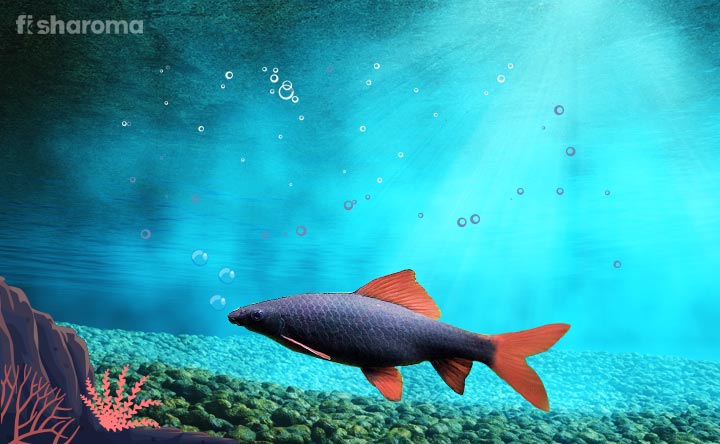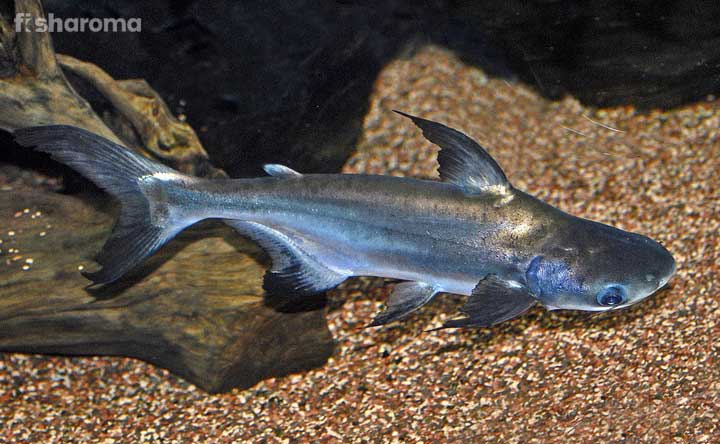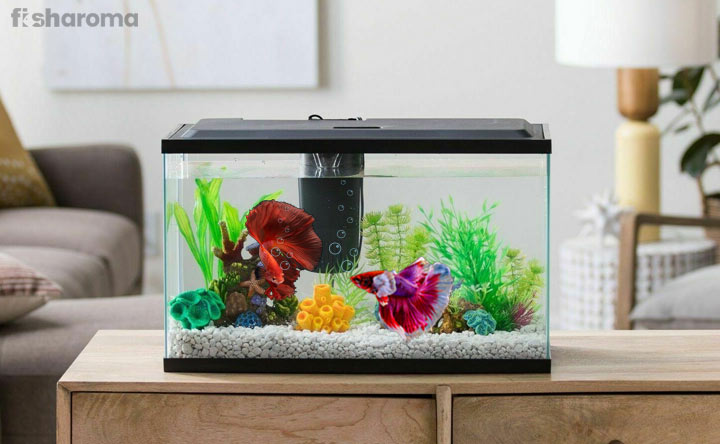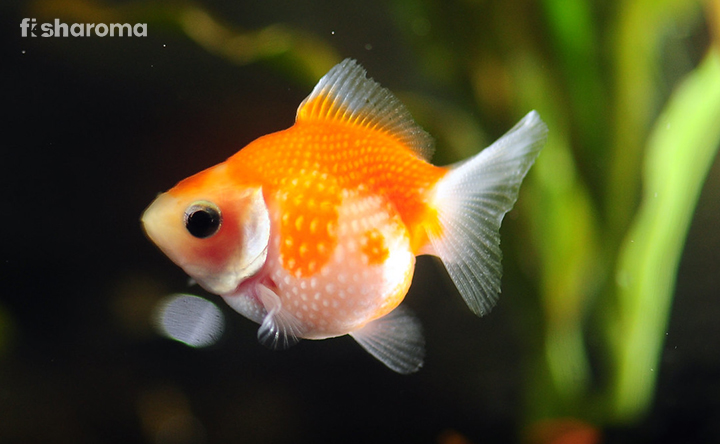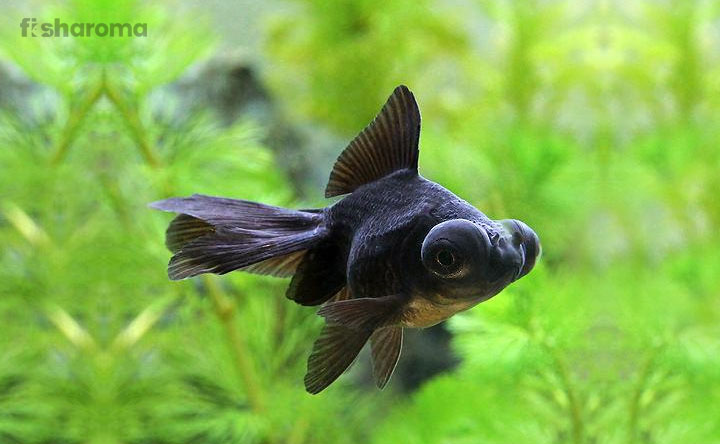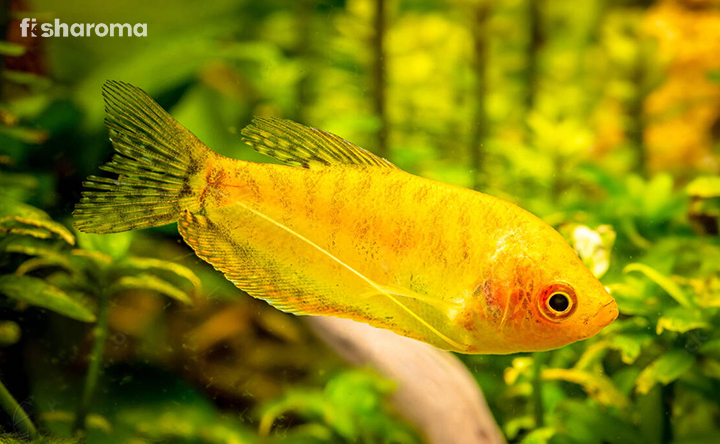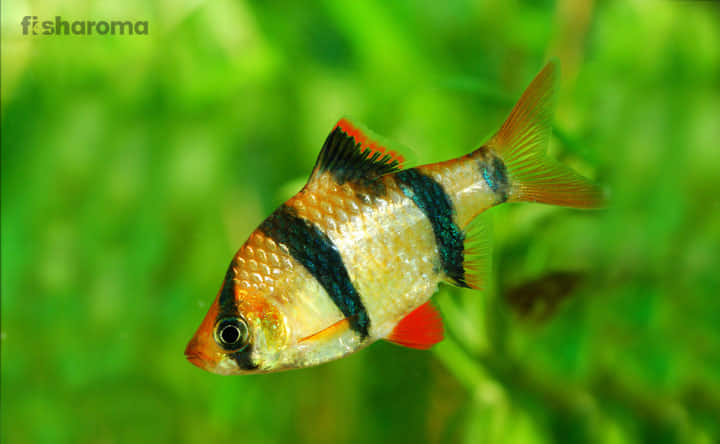The Ultimate Red Eye Puffer Care Guide

- Origin & Habitat of Red Eye Puffer
- Appearance of Red Eye Puffer
- Behaviour of Red Eye Puffer
- Lifespan of Red Eye Puffer
- Diet of Red Eye Puffer
- Tank Requirements for Red Eye Puffer
- Water Types for Red Eye Puffer
- Compatibility of Red Eye Puffer
- Breeding of Red Eye Puffer
- Diseases and Treatment of Red Eye Puffer
- Summary
Red Eye Puffer fishes are a beautiful addition to your freshwater aquarium with their interestingly designed body and highly attractive red eye. With intense aggression in nature, these small critters need a consistent internal ambience within a whole aquarium for themselves to dwell in; which demands high experience of aquarists.
Their curious personality and practice of being active, creates a call among hobbyists who want to develop a connection with their aquarium fishes. To keep these Red Eye Puffer fishes, you need to have a knowledge of intermediate to advance level of care giving; a need that our blog can imperatively satisfy.
You can find every necessary information that your Red Eye Puffer needs, in our all-inclusive piece of care guide. Let’s peek through this to get a view on their habitat, diet, tank parameters and related requirements !
Key Specifications of Red Eye Puffer
Before discussing all the necessary care level required for you Red Eye Puffer fish, let us have a quick look at their key specifications. This will help you to know these fishes in a quick and short manner.
| Scientific Name | Carinotetraodon lorteti |
| Origin | Cambodia, Thailand, Malaysia and Vietnam |
| Lifespan | Almost 5 years, though not properly known |
| Temperament | Aggressive |
| Size | 2-3 inches |
| Diet | Carnivore |
| Family | Tetraodontidae |
| Compatibility | Single |
| Tank Size | 10 gallons for one, 15-20 gallons with dense vegetation for a pair |
| Care Level | Intermediate to advance |
| Colours | Brown and having Red Eyes |
Overview
Belonging from the Tetraodontidae family, Red Eye Puffer fishes have many alternative names, which include Crested Puffer, Somphong’s Puffer and Common Red Eye Puffer. These fishes are addicted to thrive lonely and are extremely aggressive in nature. If you still want to keep other fishes with them, you can just pair them with same species.
In captivity, it is important to maintain the consistent environment, so that your pet Red Eye is able to live healthily. If you want a prolonged friendship up to five years from your Red Eye Puffer, you must provide them with intense care and proper diet.
Origin and Habitat of Red Eye Puffer
Native to lower Mekong basins in Thailand, Cambodia and Vietnam, these species are very famous in Malaysia and Indonesia also. Mainly the type series had been obtained from aquarium trade with Sumatra’s type locality.
Their natural living areas vary from forest streams to tributaries. Red Eye puffer is collectively found in submerged ripe plantation and dense vegetation of terrestrial origin. Moreover, they are closely found in murky brown water with a pH of 6 in the Samba River. As they prefer slow-moving water of rivers and ponds, they will also appreciate the same condition while in captivity.
In their habitat, they prefer a warm, acidic water with dense foliage over the water body. This helps in direct blocking their habitat from sunlight.
Appearance of Red Eye Puffer
These distinctive little varmints resemble the Classic Puffers, when it comes to their body shape. However, Crested Puffers have interesting patterns; dark lines spreading all over their body in a mess-like, unstructured fashion. These lines are golden in colour sometimes, where as their belly remain typically clear.
Their eye gives their name where it displays a beautiful bright red colour. This red colour is a stunning ring-like structure that circles the black of their eye. This, being really a stand-out feature in their appearance, these little critters will never fail to amaze you. A dark blotch is there in the anterior part of anal fins along with hyalined fins and yellow caudal fins with dark, reticulated markings
Females have intricately designed body and the males are a bit larger, with perfect sexual dimorphism. Males have a dorsal and ventral side, which is red in colour, where as females have a lacier fashion on their flanks.
Colour
The colour of the Red Eye Puffer is on the brown side, with red lining surrounding the black portion of the eye. The ventral ridge of the male fishes have a red colour too, which shows they have a red fin also.
Size
The size of these fishes generally varies from 2-3 inches, mainly for adults. In fact this size helps you to keep them even in a small tank, though that can be the last option, if no 10-gallon tank is available.
Male fishes are generally larger in size; though both the gender can grow to 3 inches fully, if proper care is taken.
Behaviour of Red Eye Puffer
Red Eye Puffer fish is nocturnal and prefers to hide out during day time. This becomes a tiresome job for aquarists to feed them as not all can stay awake at night to watch out their Puffer coming out. However, you can add the food in the evening in their water, in small quantity.
These fishes prefer to stay close to the surface, though they like to swim around the whole tank. Their aggressive nature compels the tank owners to keep them separately in one tank only, or mostly in groups of their own species. However, too many within a tank will make them fight even with own species, as they become territorial; so its better to keep a pair or only a few together. If kept with small fishes they will try to dominate them or even eat them away.
They need places to hide during day and this nature makes them fascinate strong dense foliage within the tank.
Lifespan of Red Eye Puffer
These little pets can live up to 5 years in captivity and with good care. However, in territories or forest streams, their lifespan is not known exactly.
Diet of Red Eye Puffer
Your Red Eye Puffer is wholly dependent on full-meaty foods, as they are strict carnivorous. While in your tank, they prefer to have live or frozen meaty proteins, which include :
- bloodworms
- daphnia
- mealworms
- Earthworms
- larvae (preferably mosquito).
- Mysis Shrimp
- Mussle Meat (chopped)
- Cockle Meat (chopped)
You can give them aquatic snails; even if the snail is too big, the Red Eye Puffers can have it without breaking the shell. You can also add dwarf shrimps in their diet, which will similarly tighten control their teeth.
You can help them adapt their natural feeding habitat even in captivity by giving them food twice a day, once in morning and once in evening; in small quantity. However, as they grow, their feeding requirements decrease and an adult male needs to be fed every 3-4 days, and a complete matured one requires food once in 10 days.
Do not give your pet Red Eye any kind of dried foods as they are not at all nutritous and fail to provide the required nutrition to your fish. Also avoid any kind of pellets, as they tend not to eat that.
Tank Requirements for Red Eye Puffer
The Red Eye Puffer fish is extremely sensitive to any kind of drastic change in their tank parameters, as a result of which it becomes stressed. In order to keep your Puffer healthy, you must ensure that all essentials of the tank is met, which include tank size, lighting, substrates, plants requirement and more.
Tank Size
The tank size is very important factor for Red Eye Puffer, as these fishes need at least 5-10 gallon of water to dwell singly. In case you increase the number of fishes, make sure you keep at least 15-20 gallon of water for two fishes. Gradually increase the amount with number of fishes.
Tank Lid
Your Puffer can jump! Do keep your tank lid sturdy and tighten it all the time, otherwise Red Eye Puffer can jump and come out of the tank. This might hurt themselves if they fall on floor. Moreover, if you have other pets in your home, a strong tank lid can keep the fishes uninterrupted by resisting dogs or cats jumping over it.
Substrates
The Red Eye Puffer prefer to dwell in substrates and dig the ground for food, which demands a soft sandy substrates; this will not harm the soft underbelly of the fish.
Ornaments
The Red Eye Puffer fish needs beautiful decorations in it’s tank, where they can retreat while being stressed. The ornaments of your Puffer tank include aquarium wood, and a few rocks.
Filter
Filtration is very important for the tank, so that the water remains completely pure and healthy. However, in their natural habitat, these Red Eye Puffers are habituated with slow moving water; this implies that you must keep the current of water in your tank very low. High flow will make the fish stressed as they fail to settle and thus, refuse to eat.
Filters generally make the water movement high, so you are recommended to keep the flow of filter low. You can choose for Siphon Vacuum Gravel cleaner to remove the dirt from substrates. As puffers are messy fish, they make a tank dirty, which needs a proper filtration through Sponge Filter on Hang-On-Back Filter. The Sponge Filter will work as a backup in case the HOB stops.
Presence of Flora
These fishes like a heavy plantation in their vicinity as they like to hide when they are spooked. Since they prefer a dim light where blockage of direct sunlight helps them to swim gracefully, they prefer this shelter in their tank.
Live plants are best for them as they become bored easily and like to conceal themselves within plants’ leaves. You can put Cryptocoryne wendtii, Java Moss, Java Ferns or even any kind of floating plants. The floating plants provide shade within the tank water and this helps the fishes to swim elegantly.
The tank of the Red Eye Puffer must be fully covered with intense vegetation and canopies of plants.
Lighting
For your Red Eye Puffer, you can use t5 High Output lamps as these lights provide bright light to the plants and help them grow. However, this light must be sufficient for plants and not too much for your fish. The extreme brightness of lights might unnerve the Red Eye Puffer.
You can also use LED light; it serves best for dimly-lighted decoration and provides enough lights for aquatic live plants.
Cleaning Method
The tank must be cleaned using a cloth dipped in water; this will help to scrape all dirt attached on the tank walls. The fishes sometimes don’t eat all the food, in that case, remove all the uneaten food before it starts breaking down. Once broken, it will affect the water and as it rots quickly, it might increases the ammonia level. Use a siphon vacuum to suck in all the accumulated dirt from the bottom of the tank.
You need to remove all algae that accumulate owing to slow-moving water so that the fish’s health is not affected by this. Remove the fishes and keep them for some time in a bowl with the same water parameter. Don’t hold the tank under flowing water, as it might remove the sand substrates. Immediately put the fishes in their own tank, as they cannot tolerate much change in tank space.
Water Types for Red Eye Puffer
As water quality is very important for any fish to thrive properly and healthily in a tank, your Red Eye Puffer also demands the same. The temperature, pH and hardness of the water must be maintained properly so that your fish does not feel wary and can live healthily in your tank. Using a water kit for testing the water quality every week is highly recommended.
Water Temperature
Red Eye Puffer fishes prefer to dwell in a bit cold temperature, where the temperature must range from 20-28 Degrees Celsius. This will help the fish to live happily in the aquarium, with a long life expectancy.
pH level
The pH level for the Red Eye Puffer must be 6.0-7.5
Hardness
The general hardness for the Red Eye Puffer must range from 1.01-12.1 dGH. A complete absence of salt is very important as these freshwater Puffers cannot withstand salt in their water.
These fishes are extremely sensitive to even small amounts of ammonia and nitrates. Avoid accumulation of these minerals in their tank.
Replacement Method
The Red Eye Puffers are very sensitive to water quality, which needs a frequent change of water of the aquarium. You need to change the water partially, but keep the flow gentle.
Compatibility of Red Eye Puffer
Red Eye Puffer is genuinely peaceful, though they become territorial when kept with too many males. They might start fighting with their own species and get themselves harmed. Moreover, these fishes also turn aggressive when they start spawning.
You can keep one male and 3-4 females in a tank and they peacefully live, without stressing one particular female during mating time. However, it is strongly recommended that you keep a Red-Eyed singly. You can however add a few invertebrates, as they don’t get much bothered with these invertebrates. You can keep Ghost Shrimp with them, sill there is a chance it becomes food to the Puffer at any time.
Providing them with enough territory to claim, you can add a few fast swimmers in their tank.
Suitable Tank Mates
- Rasboras
- Danios
- Ghost Shrimps
- Barbs
Unsuitable Tank Mates
- Too many males of same species
- Guppies
- Any smaller fishes (as it tend to eat them away or bite their fins)
Breeding of Red Eye Puffer
Breeding of Red Eye Puffer is actually aggressive and tough work to initiate in home aquarium, though it is not challenging. There must be enough large live plants and a large amount of water for giving the Red Eye Puffer a chance to mate. Before planning to put them to spawn, provide them with a high-protein diet.
Their mating procedure is interesting to watch at, as the males use their dorsal and ventral fins to dominate the courtship process.
Breeding of these fishes requires a lower pH level, preferably 6-6.5. During spawning, they bring out semi-adhesive kind of eggs. After the eggs are laid over Java Moss leaves, the females get away from that place. Once the courtship is completed, the male tends to drive away the female, taking the responsibility of eggs till they hatch after 72 hours.
For the first day at least, the fries live off the yolk sacs and then they are ready to accept infusoria or fresh baby shrimps. Being a fussy eater, the Red Eye Puffer parents don’t mind even eating away their babies once they are able to swim. So, it is suggested that you remove the parents to other tanks.
Diseases and Treatment of Red Eye Puffer
Red Eye Puffers, as such, don’t contact any disease of deadly kind; though they are prone to Ich or white spots and Finrot.
Ich occurs due to stress that happens during transportation or any kind of poor water quality, while they live in sellers tank. Finrot occurs when many Red Eyed are placed together in a same tank. Apart from these two, internal parasites like tapeworms also occur in these fishes as they intake crustaceans; these parasites use hosts like snails and crabs.
In order to treat your fish, you need put proper medication to them as tapeworms consume whole of the nutrients of Puffers and they starve to death. You can use dewormer to keep aside these parasites.
Summary
These little critters, though not extravagantly colourful, still have many interesting designs in their body, which make a must-keep in your aquarium; knowing they are aggressive with any other fishes and will occupy the whole of your 15-gallon tank alone. Once you are ready to accept the beautiful challenge of petting a fish, where you want a lone fish, Red Eye Puffer would be worth it. Your little companion will keep you engaging throughout the day with their movement, need for water change and aggressive courtship process.
- These Fishes don’t have teeth as such, rather the jawbone grows and has modified itself into teeth-like structures, which surprisingly grow at an advanced rate.
- The interesting fact about these fishes, they thrive on aquatic snails and crab legs, which is quite an uncommon diet. Having the snails control their teeth size and biting them helps to file them properly.
Care Guide to similar pets
If you find our blog interesting, then keep yourself engaging in reading the following similar articles.
- Care guide to Puffer Fish: If you want to have a perfect blend of adorability and scariness, you can certainly keep these inflatable Puffer Fish in your aquarium. Read our blog to know about their care guide !
- Care Guide to Bichir Fish: These Eel like living fossils will add another level of beauty in your aquarium. Know more about it’s extraordinary appearance and carnivorous nature of feeding.
- Care Guide to Tiger Barb: Barbs are suitable for keeping with your favourite Red Eye Puffer, To bring these Tiger Barbs home and keep them happy, you need to read our guide.

